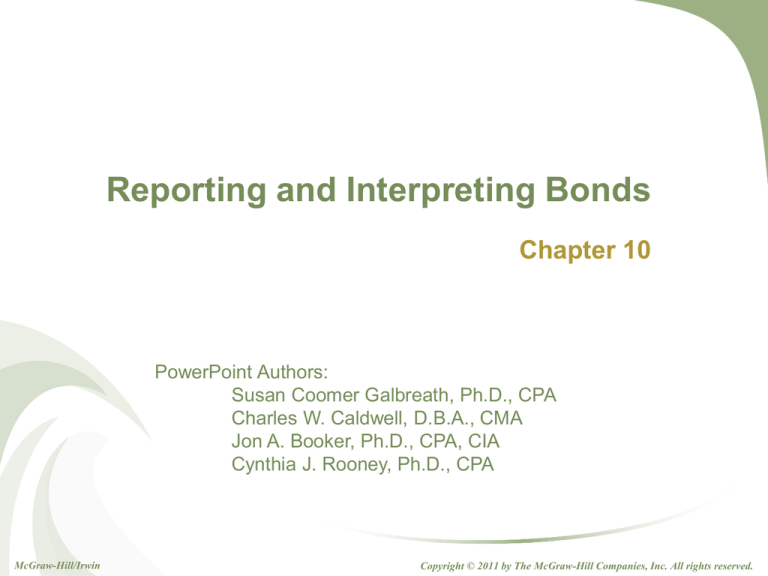
Reporting and Interpreting Bonds
Chapter 10
PowerPoint Authors:
Susan Coomer Galbreath, Ph.D., CPA
Charles W. Caldwell, D.B.A., CMA
Jon A. Booker, Ph.D., CPA, CIA
Cynthia J. Rooney, Ph.D., CPA
McGraw-Hill/Irwin
Copyright © 2011 by The McGraw-Hill Companies, Inc. All rights reserved.
Understanding the Business
The mixture of debt and equity used
to finance a company’s operations is
called the capital structure:
Debt - funds
from creditors
10-2
Equity - funds
from owners
Characteristics of Bonds Payable
Advantages of bonds:
• Stockholders maintain
control because bonds
are debt, not equity.
• Interest expense is tax
deductible.
• The impact on earnings is
positive because money
can often be borrowed at
a low interest rate and
invested at a higher
interest rate.
10-3
Disadvantages of bonds:
• Risk of bankruptcy exists
because the interest and
debt must be paid back as
scheduled or creditors will
force legal action.
• Negative impact on cash
flows exists because
interest and principal must
be repaid in the future.
Characteristics of Bonds Payable
Two types of cash payment in the bond contract:
1. Principal.
2. Cash interest payments.
Bond Terms
1. Principal, par value and face
value
2. Contract, stated, or coupon
rate of interest
3. Market, yield, or effectiveinterest rate
10-4
Characteristics of Bonds Payable
An indenture is a bond contract that
specifies the legal provisions of a
bond issue.
Debenture bonds
No assets are pledged as guarantee of repayment at maturity.
Secured bonds
Specific assets are pledged as guarantee of repayment at
maturity.
Callable bonds
Bond may be called for early retirement by the issuer.
Convertible bonds
Bond may be converted to other securities (usually common stock).
10-5
Characteristics of Bonds Payable
• The bond indenture contains
covenants designed to protect
the creditors.
• The bond issuer also prepares a
prospectus, which describes the
company, the bonds, and how the
proceeds of the bonds will be
used.
• The trustee makes sure the
issuer fulfills all of the provisions
of the bond indenture.
10-6
Reporting Bond Transactions
Present Value of the Principal (a single payment)
+ Present Value of the Interest Payments (an annuity)
= Issue Price of the Bond
Interest
Rates
10-7
Bond
Price
Stated
Rate
=
Market Bond
Par Value
=
Rate Price
of the Bond
Stated
Rate
< Market Bond <
Stated
Rate
> Market Bond >
Rate
Rate
Price
Price
Accounting for
the Difference
There is no difference
to account for.
Par Value
of the Bond
The difference is accounted
for as a bond discount.
Par Value
of the Bond
The difference is accounted
for as a bond premium.
Times Interest Earned
Times Interest
=
Earned
Net income + Interest expense
+ Income tax expense
Interest expense
The ratio shows the amount of resources
generated for each dollar of interest
expense. In general, a high ratio is
viewed more favorable than a low ratio.
10-8
Reporting Interest Expense:
Straight-line Amortization
10-9
Identify the amount of the
bond discount.
Divide the bond discount by
the number of interest
periods.
Include the discount
amortization amount as part
of the periodic interest
expense entry.
The discount will be reduced
to zero by the maturity date.
Reporting Interest Expense:
Effective-interest Amortization
The effective interest method
is the theoretically preferred
method.
Compute interest expense by
multiplying the current unpaid
balance times the market rate
of interest.
The discount amortization is
the difference between
interest expense and the cash
paid (or accrued) for interest.
10-10
Zero Coupon Bonds
Zero coupon bonds do not pay
periodic interest.
Because there is no interest annuity, the
PV of the Principal = Issue Price of the Bonds
10-11
This is called a deep discount
bond.
Debt-to-Equity
Debt-to-Equity
=
Total Liabilities
Stockholders’ Equity
This ratio shows the relationship between
the amount of capital provided by owners
and the amount provided by creditors. In
general, a high ratio suggest that a
company relies heavily on funds provided
by creditors.
10-12
Early Retirement of Debt
Occasionally, the issuing
company will call (repay
early) some or all of its
bonds.
Gains/losses are
calculated by comparing
the bond call amount
with the book value of the
bond.
Book Value > Retirement Price = Gain
Book Value < Retirement Price = Loss
10-13
Focus on Cash Flows
Financing Activities –
Issue of bonds (cash inflow)
Retire debt (cash outflow)
Repay bond principal at maturity (cash
outflow)
Remember that
payment of interest
under U.S. GAAP is
an operating activity.
10-14
End of Chapter 10
10-15








